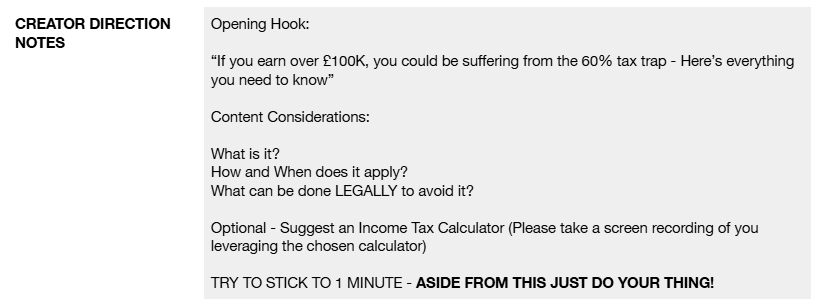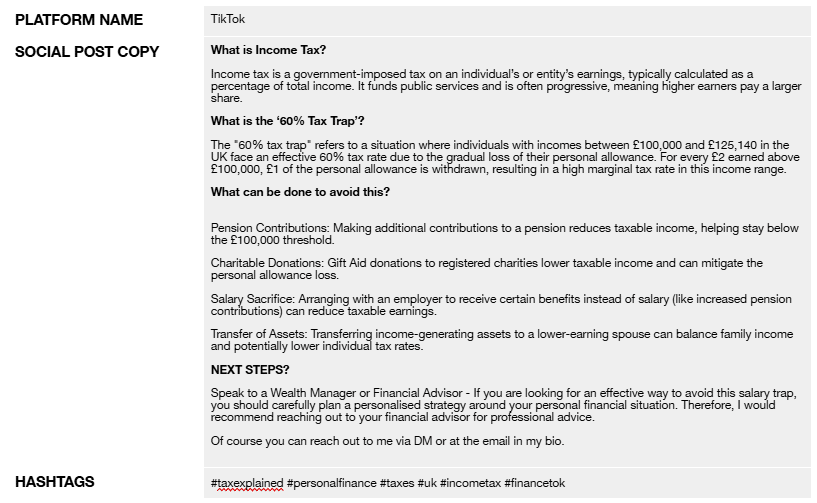
Getting the best out of a content creator partnership for social search starts with a strong brief.
Without clear, actionable guidelines, even the best creators can miss the mark, leading to off-tone content that lacks SEO impact and falls short of your strategy.
This article covers how a well-crafted brief can help bridge the gap between your marketing vision and the high-performing content you need.
Setting the scene for your creators
When working with content creators, it’s important to remember that many are encountering SEO briefs for the first time.
Contextualizing the content within a larger strategy can go a long way in helping them understand your objectives and align their work with your needs. Make sure to:
- Clarify the overall objective of the content within your brand’s search journey.
- Define the role of the content on a platform-specific level to ensure it aligns with the unique audience and purpose of each platform.
For example, a piece of content crafted for informational discovery on TikTok is unlikely to serve as effective transactional content later in the journey on a different platform, like your website.
By setting clear goals for each content activation, you can determine which platforms best support those objectives and design content accordingly.
Completing a search universe analysis is particularly helpful here, allowing you to map out where and how to reach your target audiences.
The first essential elements of a content brief should include:
Search intent
Search intent reflects the underlying purpose behind a user’s query, and understanding this intent is crucial for creating effective content.
As you explore the nuances of intent across multiple platforms, aligning content with specific search intents can significantly boost relevance and engagement.
By identifying different types of search intent in your briefing process, you can ensure content resonates with users’ needs at each stage of their journey.
User journey stage and touchpoint number
Identifying your audience’s stage in their journey with your brand or solution is key to tailoring content effectively.
Each stage calls for a unique approach. Understanding the specific touchpoints can make a significant difference.
The more familiar users are with your brand, the more likely they will progress along the journey.
By mapping out these stages and touchpoints, you can incorporate your findings into the briefing process, helping content creators understand where the audience will likely be in their relationship with your brand.
Content lifecycle
Content lifecycle refers to the planned duration and evolution of content pieces over time.
- Is the activation a reactive piece, leveraging a trend that makes timely creation essential?
- Is it a seasonal piece that relies on a specific creative foundation?
- Or is it a foundational or “evergreen” piece with longevity and recyclability at its core?
These are all questions and considerations that you can ask yourself as you begin briefing. When you have the answers, you can set the scene for your creator, informing them:
- Who the content is for.
- Where it will be deployed.
- What the content may include (basic suggestions).
- Why the content is being produced.
- When the content will be published (if seasonal/reactive).
In your brief, include an overview at the top that provides a summary, like the example below:

Content expectations
Now that the scene is set and your creator understands the basic expectations for the content, it’s time to focus on execution.
Set a framework that will help you effectively communicate the necessary information to your content creator partners.
The basics
Establish the basic information, almost the housekeeping checks, that will take place for every brief or deliverable you execute. These include:
- Project name: The unique name or title that identifies this project, often reflecting its purpose, goal or a specific campaign theme.
- Client name: The name of the business or individual commissioning the project, serving as the primary source of direction and approval.
- Stakeholders: Key individuals or groups with a vested interest in the project, including those involved in decision-making, creation and publishing the content.
- Key deadlines: The specific dates by which drafts or the final content delivery need to be completed and then published, ensuring timely delivery and alignment with other activities.
- Legal resources: Documents, guidelines or teams available to ensure all project elements comply with legal standards, brand policies and any necessary contracts.
- Style guide / brand guides: Share a link to any resource that outlines visual and branding elements – such as color schemes, logo usage and typography – to maintain consistent brand representation.
- Tone of voice (TOV): Guidelines for the style and personality of the language used, ensuring that the messaging aligns with the brand’s identity and appeals to the target audience.
- Related deliverables: Other materials or content pieces linked to the project, such as social posts, videos or blog articles, that contribute to the overall campaign or project objectives.
Tip: Ideally, you will have vetted creators to align your TOV expectations with the creator before you brief them on content.
Content goals and targets
The next step in your framework is to define the content goals and targets, clarifying your expectations for the piece.
You can reference elements from your overview here to reinforce key information for your creator partner. This section of your brief should include the following:
- Audience: The persona focus, audience group or demographic that this content should focus on reaching and building a connection with.
- Content objectives: The primary purpose or goal of the content, such as to inform, entertain, inspire or convert the audience, aligning with the broader strategic goals for the campaign.
- KPIs: Measurable metrics set to gauge the project’s success. These should be set at the platform and campaign levels.
- Journey phase: The stage in the search journey the content is aimed at, such as awareness, consideration or decision, to ensure relevance and impact from your content.
- User-need solved: The specific problem, question or desire of the target audience that the content will address, helping to position the content as valuable and solution-oriented.
- Pillar keyword focus and cluster keywords: Specific SEO-researched keywords (mapped to social platforms) that capture the main topics of the content to help users find the content based on relevant queries.
Content scripts / content direction notes
With the administrative aspects of the brief complete, the foundation is set. It’s time for creators to do what they do best: create!
When it comes to content direction, the brief should take a “hands-off” approach. Instead of providing complete scripts for creators to replicate, embrace their unique creativity.
This is where top-level content direction becomes essential. Rather than dictating every detail, focus on defining the primary themes, tone and objectives (as outlined in the content goals and targets section).
This ensures the content aligns with key priorities, like capturing the right brand voice and addressing audience needs, while leaving room for creators to add their authentic touch.
Authenticity is crucial. To truly resonate with your audience and build a meaningful community connection, content must feel natural and fitting for social platforms – unlike a traditional ad or forced marketing message. You achieve this by leveraging creators’ individual styles and insights.
Finally, maintain an open feedback loop. Encourage creators to ask questions and confirm direction as needed, minimizing revisions and making adjustments as you go.
Fostering trust in their expertise strengthens the working relationship and results in organic, impactful social content that drives engagement.
Here is an example of this approach:

Content creator briefing: Top tips
Start with a clear content goal
Establish the main objective of the content within your overview/summary.
Whether the goal is to drive traffic, boost engagement, educate the audience or improve conversions, make sure the creator understands the purpose behind the piece.
This will help them align their creative approach with the desired outcome.
Provide focus keywords, but don’t overload
Include your primary keywords (such as “60% tax trap”) and a few related keywords (like “£100K income tax” and “Income Tax Calculator”).
Mention these in the Content goals and targets section of the brief to guide creators on what terms should be emphasized naturally in the content.
Suggest an engaging hook based on search intent
Give creators ideas for an attention-grabbing opening that aligns with search intent.
A hook like “If you earn over £100K, you might be hit by the 60% tax trap…” directly addresses the reader’s problem, meets the needs of the algorithm it was being created for (TikTok) and encourages audiences to keep watching the content.
Outline key points to cover, but leave room for creativity
Instead of providing an entire script, outline the essential topics (e.g., what the tax trap is, when it applies and legal ways to avoid it).
This gives creators structure while allowing them the freedom to bring their own voice and style to the content.
Your key points could be products, questions, a review or features, depending on the specific needs of your content.
Define the target audience clearly
Describe the intended audience in detail. It should align perfectly with the creator’s audience.
Include demographics, preferences and any specific concerns related to the topic. The more the creator understands, the better they can tailor the content’s tone and approach.
Encourage visual elements that support SEO
Let creators embrace and include visuals beyond products and service shots, such as screenshots, infographics or on-screen calculators.
Visuals can help keep viewers engaged and social search platforms consider engagement metrics in their rankings.
Specify a platform-appropriate tone of voice
For SEO content on social platforms, you need to allow creators to use a tone that matches the platform culture.
This may make your brand slightly more casual on a platform like TikTok than your TOV guidelines.
When briefing, be clear about how far the TOV can be pushed. This will help creators produce content that resonates with audiences across different channels while aligning with your brand expectations.
Set clear guidelines on content type expectations
If it’s video content, recommend a length that suits the platform. For example, short-form is for TikTok and YouTube Shorts, but long-form is for YouTube and traditional SEO.
You may opt for images for use on Instagram and Pinterest. Be clear on the expectations here.
Emphasize natural keyword use
Remind creators that keyword use should feel natural.
Forced keywords can lower content quality and hurt engagement, so encourage them to use phrases that fit naturally within the conversation.
Encourage feedback and open communication
Give creators a clear communication and feedback route to quickly clarify any part of the brief.
Open communication ensures everyone stays aligned and helps prevent revisions or misunderstandings.
It also encourages a more collaborative relationship, allowing creators to seek input on SEO elements they may not be familiar with at this stage.
Next steps
Your creator partner has submitted their content, and it seems to hit the SEO markers you’ve set while also being engaging for social search platforms. What’s next?
In addition to the great creative work from your creator, the content needs to be supported by search-optimized titles, effective captions and a focused description.
Here’s what you need to do next.
Content description / social post copy
The main text or message to be used in the content or social post.
This should feature a keyword-rich coverage of the content, supporting the visual / video elements from the post and amplifying the key message.
Hashtags
Specific keywords or phrases prefixed with a “#” help categorize the content and increase its discoverability on a social search platform.
Hashtags should be relevant to the topic and audience. For certain campaigns, you may opt to create a branded hashtag.
Search everywhere amplification and adaptation
Identify opportunities to extend the reach of the content across multiple platforms and channels, adapting it as needed for each one.
Planning for content recycling and future use on other platforms now ensures an effective strategy. This could involve:
- Reformatting the content for different social media channels.
- Extracting key quotes for traditional SEO efforts.
- Adjusting the messaging to better align with various audience segments.
Here is an example:


The power of a well-crafted brief: Aligning strategy, SEO and creator authenticity
In today’s landscape, where social search platforms are central to brand visibility and audience engagement, briefing content creators is essential for ensuring alignment with brand goals and effectiveness in SEO.
To thrive in this search-driven ecosystem, brands must go beyond basic guidelines and develop robust, tailored briefs. These should support creators in delivering content that reflects the brand’s voice and is optimized for search engines and social impact.
By setting clear objectives, establishing platform-specific expectations and providing a thoughtful balance of guidance and creative freedom, brands can align their strategic vision with the creator’s output.
When creators fully understand the “what, why, where, when and how” of each project, with SEO and social goals seamlessly integrated into the brief, they are equipped to produce content that is more likely to deliver measurable results.
Ultimately, an effective content briefing process allows brands to tap into each creator’s unique style and authenticity while meeting essential SEO and strategic benchmarks.
The outcome?
High-performing content that resonates with audiences, aligns with social-search algorithms and drives meaningful campaign success.
https://searchengineland.com/brief-content-creator-social-search-marketing-448090